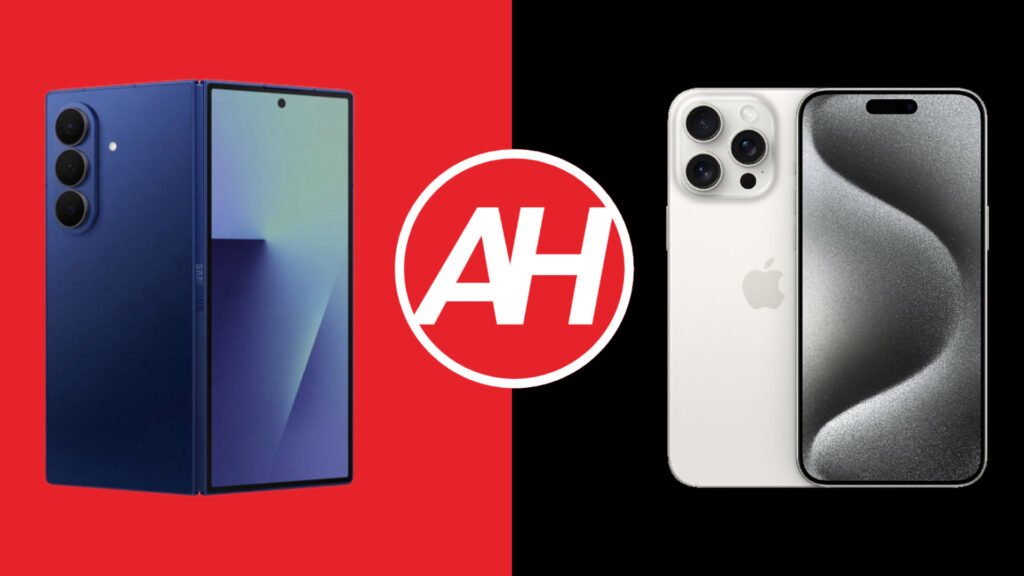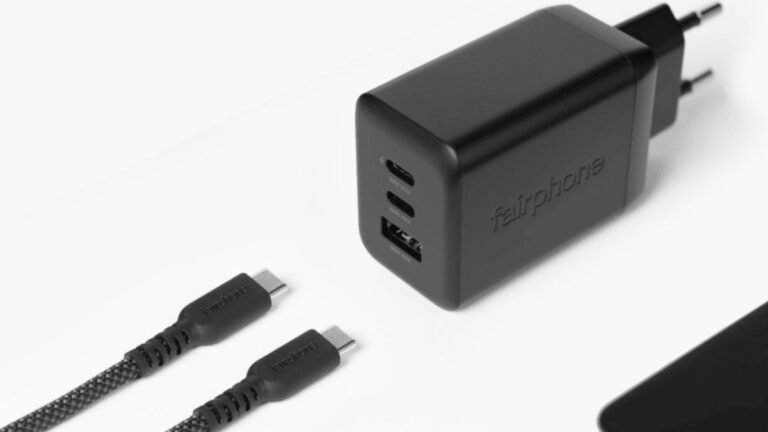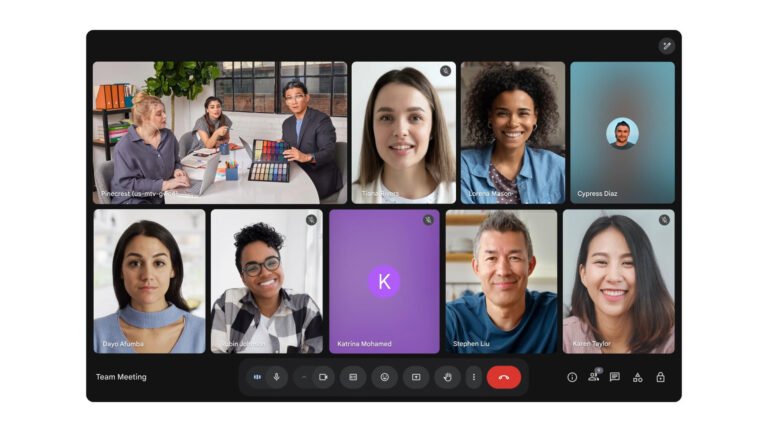

The time has come to compare the iPhone 15 Pro Max with the very best foldable smartphones Samsung has to offer at the moment. In other words, we’ll be comparing the Samsung Galaxy Z Fold 7 vs Apple iPhone 15 Pro Max. Needless to say, these two smartphones are quite different. One is foldable, and the other is not. That’s not all, though, not even close. They look entirely different, while their internals also differ quite a bit.
As we usually do, we’ll first list the specs of both smartphones. Following that, we’ll compare their designs, displays, performance, battery life, cameras, and audio output. There is a lot to talk about here, so let’s see how the Galaxy Z Fold 7 compares to the iPhone 15 Pro Max that arrived a generation before Samsung’s latest foldable.
Specs

Samsung Galaxy Z Fold 7

Apple iPhone 15 Pro Max
| Samsung Galaxy Z Fold 7 | Apple iPhone 15 Pro Max | |
|---|---|---|
| Dimensions (unfolded/folded) | 158.4 x 143.2 x 4.2mm / 158.4 x 72.8 x 8.9mm | 159.9 x 76.7 x 8.3 mm |
| Weight | 215 grams | 221 grams |
| Main display | 8-inch Dynamic AMOLED 2X (1-120Hz) | 6.7-inch LTPO Super Retina XDR OLED (1-120Hz) |
| Cover display | 6.5-inch Dynamic AMOLED 2X (1-120Hz) | N/A |
| Resolution | 2184 x 1968 / 2520 x 1080 | 2796 x 1290 |
| Chipset | Qualcomm Snapdragon 8 Elite for Galaxy | Apple A17 Pro |
| RAM | 12GB (LPDDR5X) | 256GB/512GB (NVMe) |
| Storage | 256GB/512GB (UFS 4.0) | 128GB/256GB/512GB/1TB (NVMe) |
| Main camera | 200MP (f/1.7 aperture, OIS, Quad Pixel AF, 0.6um pixel size, 85-degree FoV) | 48MP (f/1.8 aperture, 1/1.28-inch sensor size, 1.22um pixel size, dual pixel PDAF, sensor-shift OIS) |
| Ultra-wide camera | 12MP (f/2.2 aperture, Dual Pixel AF, 1.4um pixel size, 120-degree FoV) | 12MP (f/2.2 aperture, 1/2.55-inch sensor size, 120-degree FoV, 1.4um pixel size, dual pixel PDAF) |
| Telephoto camera | 10MP (f/2.4 aperture, PDAF, 36-degree FoV, 3x optical zoom) | N/A |
| Periscope camera | N/A | 12MP (f/2.8 aperture, 1/3.06-inch sensor size, 1.12um pixel size, dual pixel PDAF, 5x optical zoom) |
| Selfie camera(s) | 10MP (f/2.2 aperture, 1.12um pixel size, 85-degree FoV) | 12MP (f/1.9 aperture, 1/3.6-inch sensor size, PDAF, OIS) |
| Battery size | 4,400mAh | 4,441mAh |
| Charging | 25W wired, 15W wireless, 4.5W reverse wireless (charger not included) | 20W wired, 15W wireless (MagSafe & Qi2), 7.5W wireless (Qi), 4.5W reverse wired (charger not included) |
| Colors | Blue Shadow, Jetblack, Silver Shadow | Black Titanium, White Titanium, Blue Titanium, Natural Titanium |
Samsung Galaxy Z Fold 7 vs Apple iPhone 15 Pro Max: Design
The Samsung Galaxy Z Fold 7 is made out of aluminum and glass, while some titanium is used in its hinge. The iPhone 15 Pro Max is made out of titanium and glass. Samsung’s foldable is actually quite boxy, with sharp corners and flat sides. The iPhone 15 Pro Max has rounded corners, but it’s flat in every other way. Its front and back sides are flat, and the same goes for the phone’s frame.
The Galaxy Z Fold 7 has a centered display camera hole on the cover display. A display camera hole also sits on the phone’s main panel, though. The iPhone 15 Pro Max has the so-called Dynamic Island, which is a pill-shaped camera cutout at the top of the display. Samsung’s handset has both of its physical keys on the right-hand side. The iPhone 15 Pro Max includes the power/lock button on the right side, while the volume rocker buttons are on the left. The Action Key is also on the left side.
If we flip the two phones around, you’ll notice that the Galaxy Z Fold 7 has three vertically-aligned cameras. They’re placed in the top-left corner, and included on top of a pill-shaped camera island. The iPhone 15 Pro Max has three cameras on the back too, in the top-left corner, but their layout is rather odd. Well, it’s not compared to previous iPhone Pro models, but in the general sense of things, it sure is.
The Galaxy Z Fold 7 is barely thicker than the iPhone 15 Pro Max when folded, despite the fact it’s a foldable. It’s also 6 grams lighter in comparison, which is quite a feat for Samsung. Samsung’s handset is a bit shorter and quite a bit narrower when folded. It offers an IP48 certification for water resistance, while the iPhone 15 Pro Max supports an IP68 certification for water and dust resistance. Both phones are quite slippery.
Samsung Galaxy Z Fold 7 vs Apple iPhone 15 Pro Max: Display
The Samsung Galaxy Z Fold 7 features an 8-inch Foldable Dynamic LTPO AMOLED 2X main display. That panel supports HDR10+ content, and it has a peak brightness of 2,600 nits. Its refresh rate is adaptive (1-120Hz). The screen-to-body ratio is at around 90%, while the resolution is 2184 x 1968 pixels. The cover display measures 6.5 inches, and it’s a Dynamic LTPO AMOLED 2X panel. It has a refresh rate of up to 120Hz, and the Gorilla Glass Ceramic 2 protects this panel. The resolution is 2520 x 1080 pixels.
The iPhone 15 Pro Max, on the flip side, has a 6.7-inch LTPO Super Retina XDR OLED display. This panel has an adaptive refresh rate (1-120Hz) and supports HDR10 and Dolby Vision content. The peak brightness of the display is 2,000 nits, while the screen-to-body ratio is around 89%. The resolution this display offers is 2796 x 1290, while the display aspect ratio is 19.5:9. The display is protected by the Ceramic Shield glass.
All three of these displays are really good, actually. They’re vivid, sharp, and have great viewing angles. The touch response is good, and so is the brightness. The Galaxy Z Fold 7’s main display does have some brightness issues when used in direct sunlight on warm days, but we do hope Samsung will resolve that soon. Its main display has really good crease control. We do hope that Samsung will fix the issues soon.
Samsung Galaxy Z Fold 7 vs Apple iPhone 15 Pro Max: Performance
Qualcomm’s Snapdragon 8 Elite for Galaxy chip fuels the Galaxy Z Fold 7. That is an overclocked variant of the Snapdragon 8 Elite, Qualcomm’s most powerful processor, a 3nm chip. It is paired with 12GB of LPDDR5X RAM and UFS 4.0 flash storage. The iPhone 15 Pro Max, on the other hand, is fueled by the Apple A17 Pro chip, which is a 3nm processor. It is paired with 8GB of RAM and NVMe flash storage. Neither phone offers storage expansion, by the way.
Both devices do offer great performance, though. The iPhone 15 Pro Max may be a year older, but it definitely keeps up in the performance department. Both of them are very snappy during day-to-day use, which goes for opening apps, jumping between them, consuming multimedia, and doing basically anything else on them. It’s not a problem whatsoever, and chances are it will stay that way for the foreseeable future.
What about gaming? Well, they can both handle even the most demanding games from their respective app stores. It’s not a problem whatsoever. The most demanding games will even run at very high graphical settings, as these two phones definitely can handle that sort of thing. Overheating was also not an issue for us, not at all.
Samsung Galaxy Z Fold 7 vs Apple iPhone 15 Pro Max: Battery
The Samsung Galaxy Z Fold 7 features a 4,400mAh battery on the inside. The iPhone 15 Pro Max, on the flip side, has a 4,441mAh battery. Now, the Galaxy Z Fold 7 does offer good battery life. It’s not a book-style foldable with the best battery life, but the battery life is good, not great. We were able to cross the 7-hour screen-on time, but during more intense use, the phone flies below that level.
The iPhone 15 Pro Max, on the other hand, offers great battery life, truly great. It managed to offer a couple of more hours of screen-on-time compared to the Galaxy Z Fold 7. For lighter use, this phone could easily be a two-day battery life smartphone for many people. Even if you push it quite hard, chances are it will have enough juice to get you to the end of the day.
Neither phone supports particularly fast charging. The Galaxy Z Fold 7 supports 25W wired, 15W wireless, and 4.5W reverse wireless charging. The iPhone 15 Pro Max supports 20W wired, 15W wireless, and 4.5W reverse wireless charging. Neither phone ships with a charger in the box.
Samsung Galaxy Z Fold 7 vs Apple iPhone 15 Pro Max: Cameras
The Samsung Galaxy Z Fold 7 features a 200-megapixel main camera (1/1.3-inch sensor size), a 12-megapixel ultrawide snapper (120-degree FoV), and a 20-megapixel telephoto camera (3x optical zoom). The iPhone 15 Pro Max, on the other hand, has a 48-megapixel main camera (1/1.28-inch sensor size), a 12-megapixel ultrawide unit (1/2.55-inch sensor size), and a 12-megapixel periscope telephoto camera (1/3.06-inch sensor size, 5x optical zoom).
Both of the main cameras do a great job. The Galaxy Z Fold 7 prefers to offer more vivid shots, which are more saturated, while the iPhone 15 Pro Max likes to keep things closer to real life. Both phones do lean towards producing warmer pictures, though. The two ultrawide cameras are okay, but nothing to write home about, while the iPhone 15 Pro Max has the edge in terms of zoom shots, but its periscope telephoto camera is nowhere near being the best periscope telephoto shooter out there.
In low light, both phones do a good job, presuming that you’ll stick to using their main cameras. They provide nice-looking, balanced pictures. Ultrawide and (periscope) telephoto cameras cannot measure up in low light, not at all. They offer notably worse images, that are noisier, and lack detail compared to the main cameras. That is to be expected considering camera sensor size differences.
Audio
Both of these smartphones include stereo speakers. The ones on the iPhone 15 Pro Max are notably louder, however. The difference is easily noticeable if you compare them directly, even though the Galaxy Z Fold 7 speakers are not quiet or anything like that. The sound quality is good on both ends.
There is no audio jack on either of these two smartphones. You can use their Type-C ports, if you’d like, though you’ll need a dongle to connect your wired headphones. Alternatively, the Galaxy Z Fold 7 features Bluetooth 5.4 support, while the iPhone 15 Pro Max supports Bluetooth 5.3.
The post Phone Comparisons: Samsung Galaxy Z Fold 7 vs Apple iPhone 15 Pro Max appeared first on Android Headlines.

